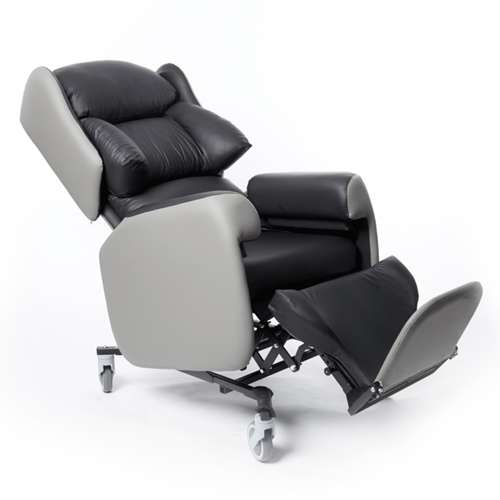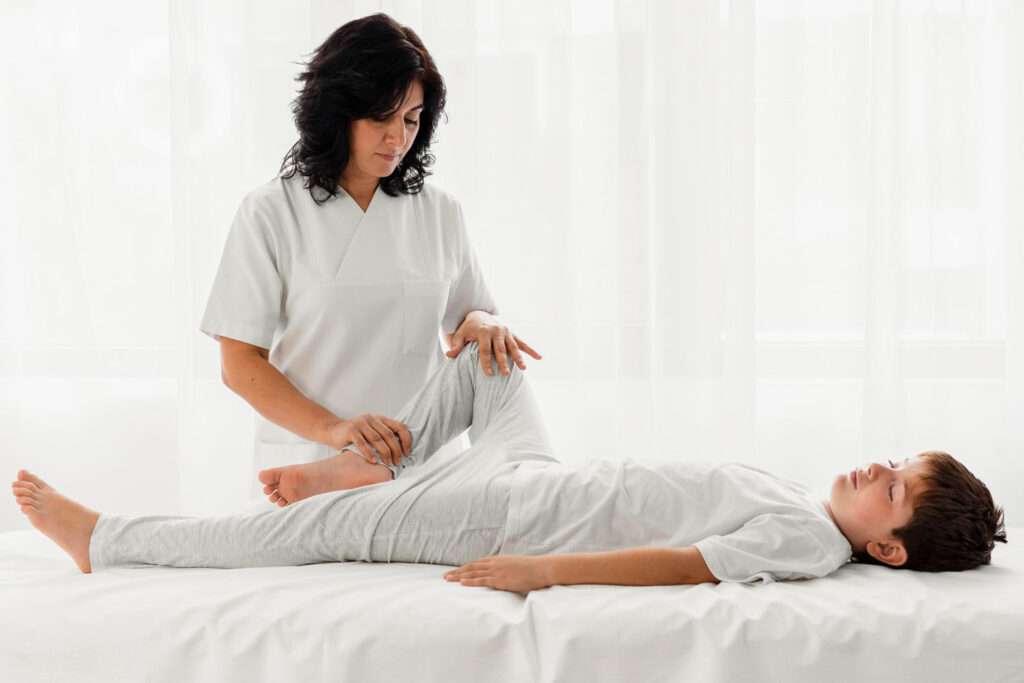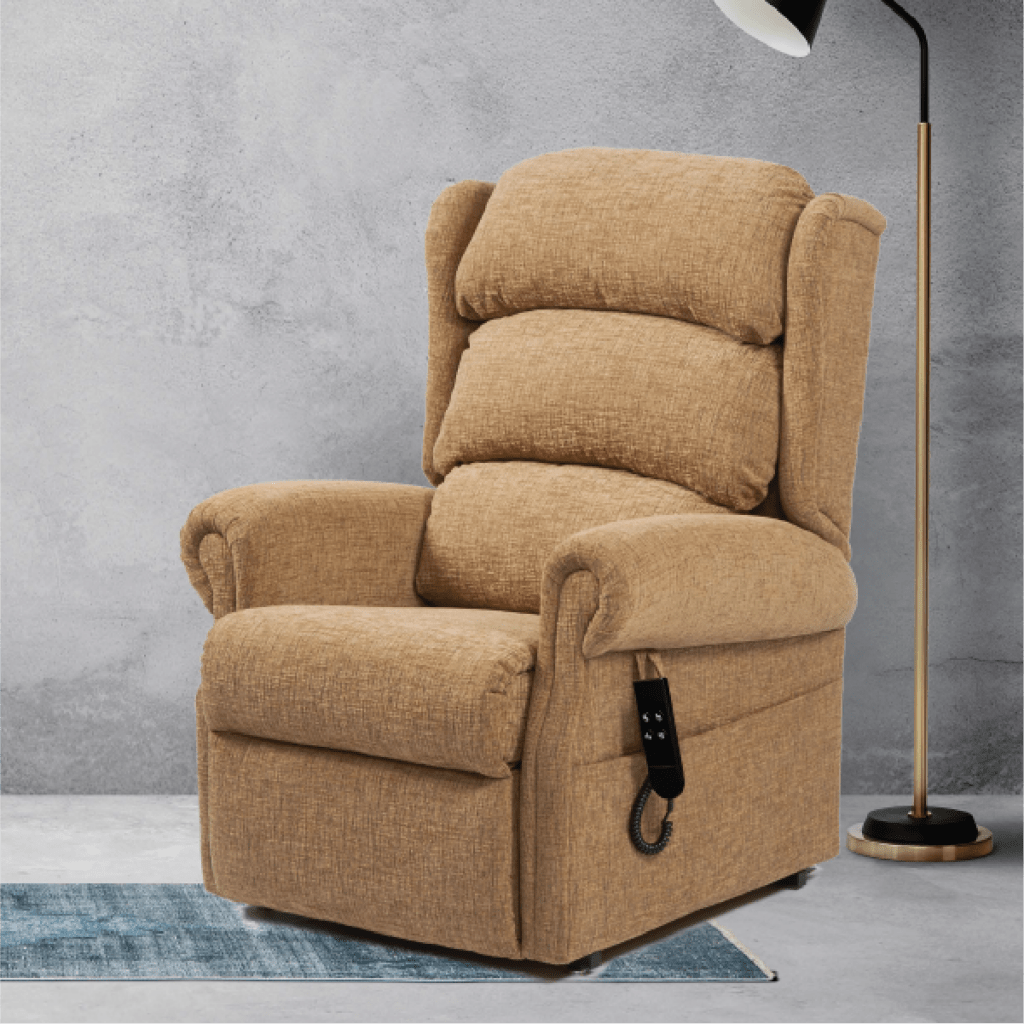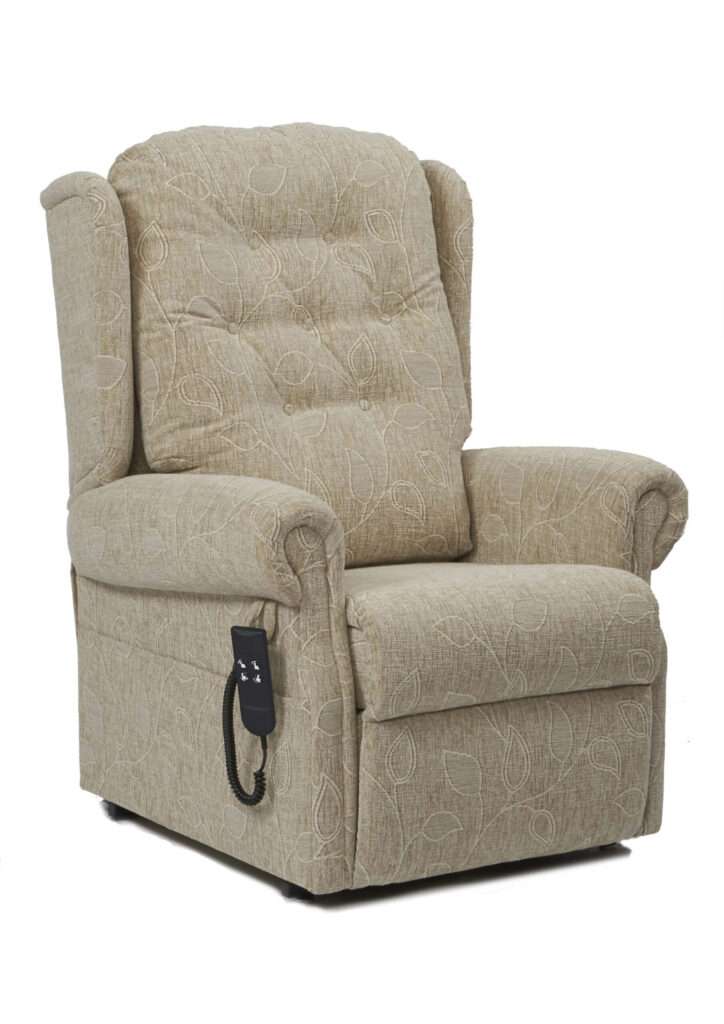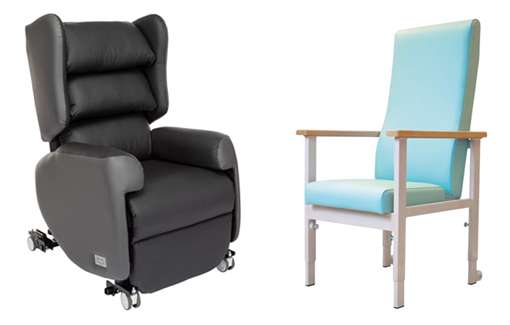Finding the ideal riser recliner or care chair for someone with Parkinson’s Disease involves finding a solution that enables better mobility and independence whilst also ensuring postural support and pressure care, which can be a challenge as it is a condition that presents itself in many different ways.
Fortunately, there are chairs available that can provide comfort and support for individuals with Parkinson’s disease. In the UK, these patient chairs or treatment chairs can usually be found in healthcare settings, hospitals, as well as care and nursing homes, anywhere that you may expect to find patients receiving treatment and rehabilitative care.
Care chairs and treatment chairs are designed to be adjustable and provide a comfortable seating option for individuals with mobility issues. These chairs can help alleviate discomfort and stiffness associated with Parkinson’s disease and allow patients to rest and recover more comfortably. With features like reclining backrests, variable angle tilt, adjustable footrests, headrests, and lumbar support, these chairs can be customized to meet individual needs and preferences.
Jump straight to…
How Does Parkinson’s Impact Seating Needs?
Parkinson’s Disease is a progressive neurological disorder that affects the central nervous system and causes damage to specific areas of the brain. By attacking nerve cells in the brain, Parkinson’s prevents the production of the hormone dopamine, which helps to regulate muscle movement. This can cause uncontrollable shaking and tremors in certain areas of the body, slow movements, balance issues and stiff muscles which reduces a person’s mobility.
You can find out more about the condition on the NHS website, including helpful details about the symptoms to look out for. The RCOT website also offers information regarding Occupational Therapy for people with Parkinson’s Disease.
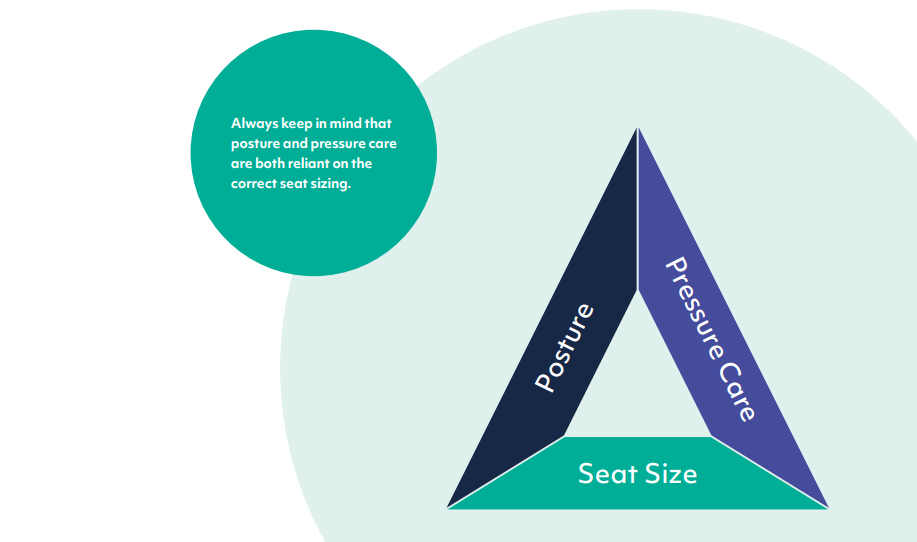
The postural instability that can be caused by Parkinson’s may also bring about, stiffness, tremors, reduced mobility. When sitting in a chair for prolonged periods of time, there is also an increased risk of pressure sores. As a result, the right chair can make a big difference in their comfort and overall wellbeing.
If you’re looking to buy a chair to help support someone with Parkinson’s disease, it’s important to consider their unique seating needs.
Specialist Chairs for People with Parkinson’s | What to Look For
When choosing a patient chair or treatment chair for someone with Parkinson’s disease, there are several key features to consider to ensure the chair provides maximum comfort and support.
When choosing a chair, it’s important to consider factors such as the person’s height, weight, and body shape, as well as any specific needs they may have due to their Parkinson’s. Look for chairs with sturdy frames, comfortable padding, and easy-to-use adjustment features.
Variable Angle Lift (VAL)
When looking for rise and recline chairs to support someone with Parkinson’s Disease, Variable Angle Lift (VAL) is a useful feature to look out for. It is a setting that can be altered on some riser recliner chairs, and give your client a few different ways to be lifted to standing from a seated position. Particularly for ambulant people, VAL gives them a little more support and peace of mind when getting to their feet.
A patient treatment recliner chair with variable angle tilt can be particularly beneficial for someone with Parkinson’s. This feature allows patients to adjust the angle of the chair to a position that is most comfortable and supportive for their body.
What is Variable Angle Tilt?
Variable angle tilt is a feature in some patient treatment chairs that allows the user to adjust the angle of the seat and backrest independently to a position that is most comfortable and supportive for their body.
This means that the angle between the seat and backrest can be changed to create a more customized and comfortable seating position. Variable angle tilt can be especially important for patients who are recovering from an illness or surgery, or who have limited mobility.
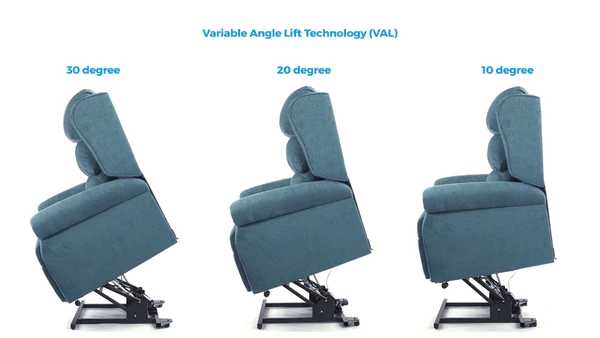
(source)
With variable angle tilt, someone who prefers to sit with their legs at a slightly different angle than their torso can adjust the seat angle to accommodate this. Similarly, someone who wants to recline slightly while still maintaining good posture can adjust the backrest angle to achieve this.
Variable angle tilt can be particularly useful for people who spend long periods sitting in a chair, as it can help to reduce the risk of discomfort and pain associated with prolonged sitting. It can also be beneficial for people with specific health conditions or injuries that require a more customized seating position.
There are usually 3 different lifting options on a chair with VAL:
- Regular rise and lift usually found in most rise and recline chairs.
- The middle setting offers a rising movement with less tilt in the seat, giving extra support to find your feet when standing up.
- A vertical rise movement which keeps the seat flat throughout.
The typical action of a riser recliner will simply tip the individual out of the chair, and if their balance or leg strength is already inhibited, this could cause them to simply fall over. With Parkinson’s, you may find that the middle option or the vertical rise is best-suited to your client. The extra support of the seat will help to find their footing and stand when ready, ultimately preventing falls.
Variable Angle Tilt Turns Your Chair Into a Standing Aid
Variable angle tilt in a patient treatment chair can help with getting out of the chair, especially for people with Parkinson’s disease who may struggle with mobility and balance.
The ability to adjust the angle of the chair can make it easier for patients to stand up from a seated position. By tilting the chair forward, the patient can shift their centre of gravity and bring their feet closer to the ground, which can make it easier to stand up. This feature can be particularly helpful for people with Parkinson’s who may have difficulty standing up from a seated position due to postural instability, stiffness, and reduced mobility.
It’s important to note that while variable angle tilt can be helpful, it’s not a replacement for proper mobility and balance training, which is essential for people with Parkinson’s. Patients should work with a healthcare provider to develop a comprehensive plan for managing their Parkinson’s symptoms, which may include the right patient treatment chair with variable angle tilt.
Raked Seating
A raked seat is positioned so the back of the seat itself is slightly lower than the front. If you’ve ever been to the theatre, then you’ve probably sat in a raked seat. This is usually used more with care chairs than it is with rise and recline models, but a raked seat can also help when it comes to supporting Parkinson’s symptoms.
People with Parkinson’s often struggle with sliding out of their chairs. Tremors and limited core strength makes it more difficult to maintain a healthy upright position when seated, meaning that those living with Parkinson’s often begin to slump and slide forwards. Having a raked seat means that the person less likely to slide forwards because their hips and pelvis are cradled in a more stable position against the backrest.
Tilt-In-Space
Tilt-in-space is also a useful thing to consider when specifying a care chair or a riser recliner. Tilt-in-space is a particularly beneficial feature on most chairs, but it has its uses specifically in chairs for people with Parkinson’s. Take a look at our more in depth insight into tilt in space.
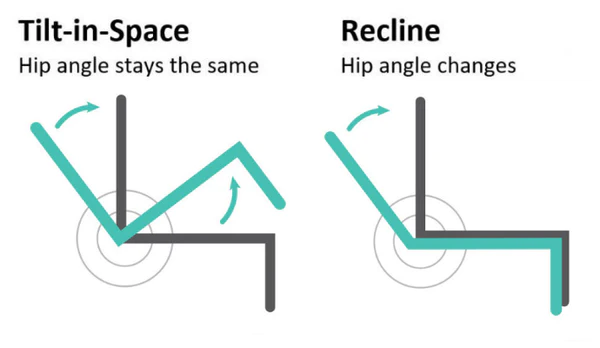
Like the raked seat, tilt-in-space will help you to maintain a healthy posture. By tilting backwards but maintaining your hip angle, tilt-in-space allows the individual to remain in the same position but with reduced pressure on their sacrum and posterior. This will help the client to keep their position despite shaking.
One particular chair that offers tilt-in-space features for those with Parkinson’s is our Lento mobile patient chair . This riser recliner actually pivots the seated person from the front of the seat, giving them the ability to attain a tilted position without their feet leaving the floor.
Positioning Supports
Non-ambulatory and ambulatory people with Parkinson’s may require some extra positioning supports in their chairs. People with Parkinson’s often develop poor posture due to muscle rigidity and stiffness, so getting their chair to be as supportive as possible is key.
People with Parkinson’s Disease are more likely to develop postural problems like a forward-leaning head, rounded shoulders, and a noticeable lean forward. Thoracic kyphosis is more likely to occur in those with Parkinson’s, so positioning supports can help to combat this. You might want to include a built-in support wherever it is most helpful on the client, and you can remove some of the wadding in the backrest around the thoracic area to reduce the chances of pressure injuries occurring.
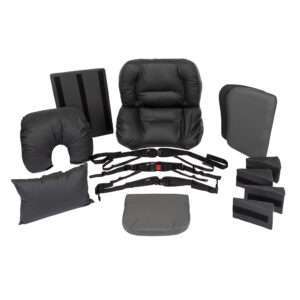
Lateral supports are also good to include, particularly if your client is leaning or slumping to one side. We would suggest using softer supports, as harder cushions can actually have an adverse effect on the individual’s posture.
Specialist chairs that provide lateral support and adjustability can help to address the issue, but in some cases, additional medical treatment or therapy may be needed to address the underlying condition. The Lento patient care and treatment chair was built to support the comfort, treatment and rehabilitation of people who may lean to one side in a chair. The care chair and riser recliner chair versions of the Lento offer an array of positioning support configurations and feature built-in lateral supports.
Pressure Relief & Waterproof Fabrics
Particularly with non-ambulatory clients, pressure relief and waterproofing are key things to consider when specifying a care chair. People with severe Parkinson’s can be sat down for hours and hours every day. This makes them much more susceptible to pressure injuries. Wherever possible, we always recommend built-in pressure relief cushions.
Waterproof fabrics are also something to be thought about when specifying for non-ambulatory clients. Parkinson’s Disease can often cause incontinence, and so ensuring that the chair (or at least the seat cushion) is covered in a waterproof fabric can be particularly useful.
Parkinson’s is a disease that varies massively from client-to-client. It’s also progressive, and so will gradually get worse over time. With that in mind, it’s best to choose chairs for people with Parkinson’s that offer flexibility and can be altered for changing needs over time.
Useful Seating Features for the Late Stages of Parkinson’s
As Parkinson’s progresses, symptoms grow and become more disruptive for the individual concerned. Some of the cognitive side effects match those of dementia, like memory loss and delusions. At this stage, drugs may start to become less effective at managing the symptoms.
Patients may have severe postural issues, like kyphosis or curvature of the spine, which will need more advanced seating to manage.
The Lento Neuro has a cocooned-shaped seat, creating space to support deformed postures and provide maximum comfort. The raked seat of the Lento Neuro keeps the patient angled back in their chair, altering their centre of gravity and relieving pressure, as well as keeping them secure and preventing them sliding forward. The incremental backrest recline also helps open up the back angle further, assisting swallowing or breathing difficulties in the late stages of the disease.
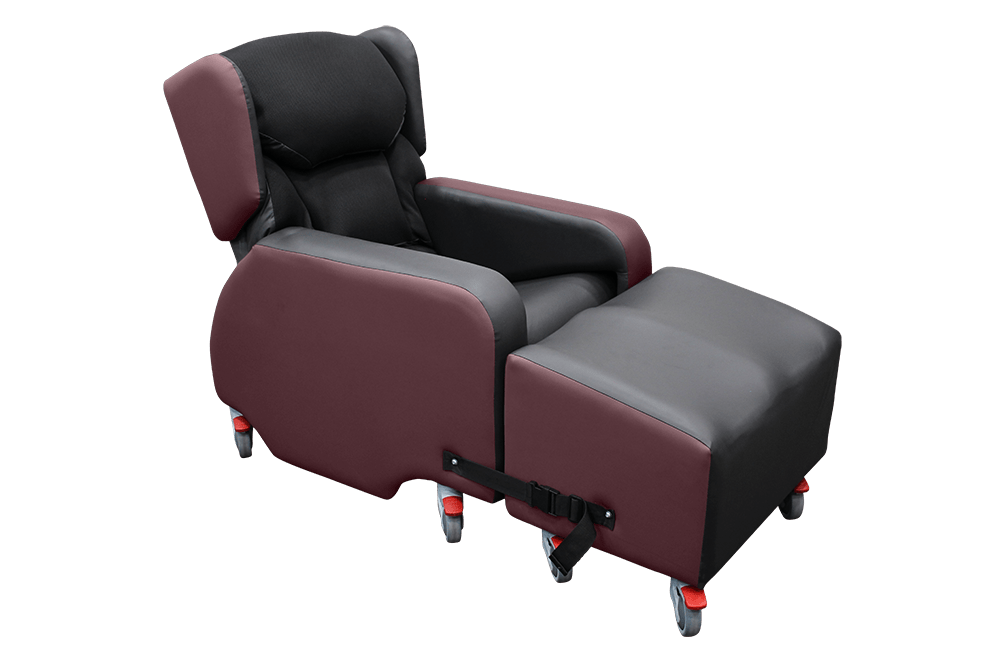
Measuring For a Chair | Seating Assessments
It is important to note that being assessed before getting a rise and recliner or care chair can be very helpful. An assessment by a qualified healthcare professional can help ensure that you get the right type of chair to meet your specific needs.
A healthcare professional can assess factors such as your size, weight, mobility, and any medical conditions you may have to recommend the most suitable type of chair for you. They can also assess your posture and provide advice on how to use the chair safely to avoid any potential harm.
In addition, an assessment can help determine if you are eligible for financial assistance to help cover the cost of the chair. Some chairs may be available through the NHS or other healthcare providers, while others may require you to purchase them privately.
Arrange an assessment
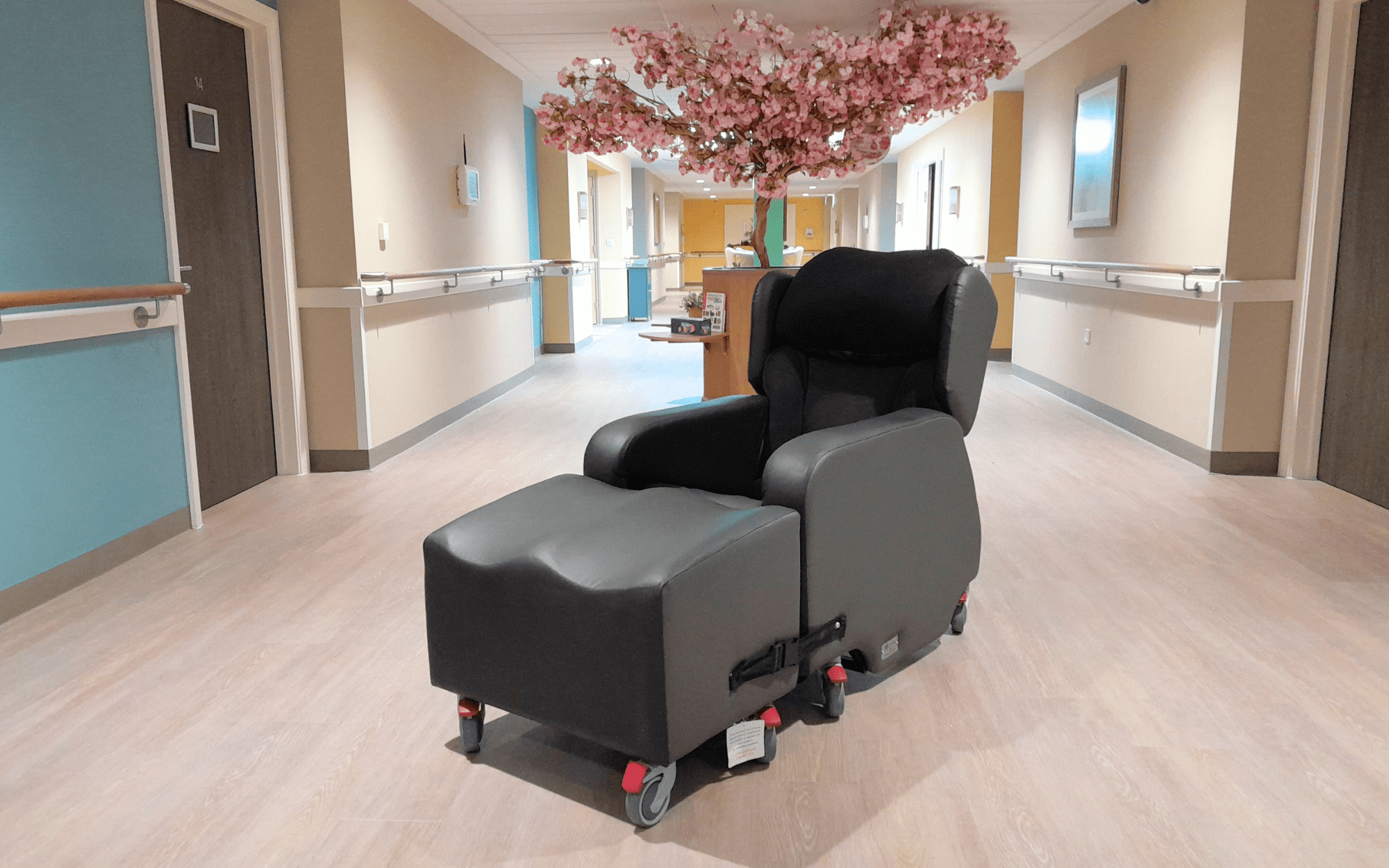
FAQs
How important is postural support in seating for someone with Parkinson’s Disease?
Postural support is absolutely essential for people with Parkinson’s Disease, as it really helps to maintain stability, reduces the risk of them falling and hurting themselves, and also alleviates condition related pain and discomfort in their joints and muscles. A carefully prescribed care chair by a healthcare professional or experienced seating assessor who understands the needs of the individual, can significantly improve the chair users quality of life by enabling better alignment.
What chair materials are best for people with Parkinson’s?
Choosing a chair with materials that are durable but still soft and supple will ensure comfort for the user, at the same time as being practical and easy to clean. Cushion materials such as the four way stretch Dartex fabric are well-known and trusted by healthcare professionals – Dartex was actually designed specifically for the NHS! Offering material colour options to people with Parkinson’s Disease can also bring that sense of individuality, and therefore extra comfort and happiness. You can read more about our material and colour options here: Materials & Colours – Vivid Care
Can specialist seating help with mobility issues associated with Parkinson’s?
A care chair with features like variable angle lift (VAL), tilt-in-space, and recline can all significantly improve mobility and independence for someone with Parkinson’s Disease. They can make simple tasks such as getting in and out of the chair that much easier! Find out more about each functionality in the blog post above, and then be sure to consult a healthcare professional or experienced seating assessor in your chair-finding journey – they understand how to meet each individual’s needs.
How often should a chair be adjusted for someone with Parkinson’s?
Parkinson’s Disease is a progressive neurological disorder, so we recommend that you assess and adjust your specialist care chair’s settings regularly based on changes in the individual’s condition and comfort levels. Always stay in touch with your Occupational Therapist, as they will be able to support and advise you as to how best to address changing care requirements.
What are the benefits of pressure relief cushions in chairs for people with Parkinson’s Disease?
You should always carefully consider pressure care needs before buying a care chair for someone with Parkinson’s Disease – cushions with pressure relief technologies can dramatically improve comfort, and will ensure that no nasty pressure ulcers develop over time. Pressure relief cushions help to distribute the users weight evenly, which is especially important when they are in a sitting position for long periods of time due to limited mobility. Find out more about pressure relief and care here: Preventing & Treating Pressure Wounds in a Chair – Vivid Care
Can a chair reduce tremors or involuntary movements from Parkinson’s disease?
Yes, although you will need to be sure that you are looking at seating solutions that are specifically designed for stability, durability, and come with a range of supportive accessories. Our Lento Neuro is a perfect example of a care chair that has been over-engineered for maximum strength and stability. Some care chairs also offer additional features such as adjustable armrests and headrests to support and stabilise individuals experiencing strong involuntary movements.
How can I fund a chair for someone with Parkinson’s?
There are various funding options available for the purchase of seating for people with Parkinson’s Disease, including insurance coverage, government assistance programs, and grants from charitable organisations. Occupational therapists and healthcare providers can assist you in finding the best funding stream for you.
We have got a charities list you can also explore: Vivid.Care Charities Database – Vivid Care

Book a Seating Assessment Today:
We understand that getting the right type of chair is crucial for your comfort, mobility, and quality of life. That’s why we offer professional assessments at your home or location of choice, to help you find the perfect chair to meet your specific needs.
Our assessors are highly trained healthcare professionals who can travel to your residence to perform the assessment in the comfort of your own home. This is designed to make you feel as comfortable and relaxed as possible during the assessment process.
During the assessment, our assessors will take the time to understand your specific needs and recommend the most suitable chair for you. They will also provide advice on how to use the chair safely to avoid any potential harm.
Arrange an assessment






